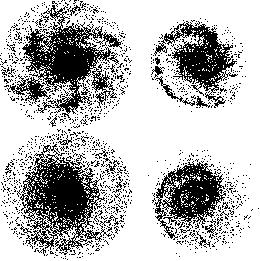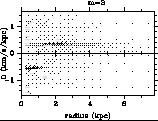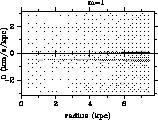


5.5. Counter-rotation with gas
The presence of two streams of gas in the same plane will be very transient: strong shocks will occur, producing heating and rapid dissipation. The gas is then driven quickly to the center. But the two streams of gas could be in inclined planes, or at different radii. This is the case in polar rings, discovered in 0.5 % of all galaxies (Whitmore et al. 1990). After correction for selection effects (non optimal viewing, dimming, etc..) 5% of all S0 would have polar rings.
If there is only one gas stream, the problem is more similar to the two-stream instabilities of stellar disks mentioned above. However the gas is cooling, and is not easy to stabilise against m = 2 components. Both m = 1 and m = 2 may be present simultaneously in these systems. This is the case of the galaxy NGC 3593, composed of two CR stellar disks (Bertola et al 1996): in an extended stellar disk, is embedded a CR nuclear disk, possessing co-rotating gas. The molecular component associated with this nuclear disk reveals both a nuclear ring and a one-arm spiral structure outside of the ring (Garcia-Burillo et al. 2000). N-body simulations have shown that both structures can be explained by the superposition of m = 1 and m = 2 in the gas component, the ring being formed at the ILR of the bar (fig. 18). In the m = 2 pattern, two counter-rotating bars develop (fig 19).

|
Figure 18. Particle plots of the stars (left) and the gas (right) for a model of the counter-rotating galaxy NGC 3593, at successive epochs 200 and 400 Myr. Particles are plotted until a radius of 6.25 kpc. The majority of stars rotate in the direct sense, while the gas is retrograde (from Garcia-Burillo et al. 2000). |

| 
|
Figure 19. Pattern speed as a function of radius, in units of 100 km/s/kpc, for the m = 2 mode, total density (left) and m = 1 mode, gas density (right), for the NGC 3593 model of fig 18. | |